Technical Area | Articles
The place to solve all your BIM doubts
The 3 Critical Pillars for Successful Digital Transformation
People, Data, and Processes
BIM Implementation IPD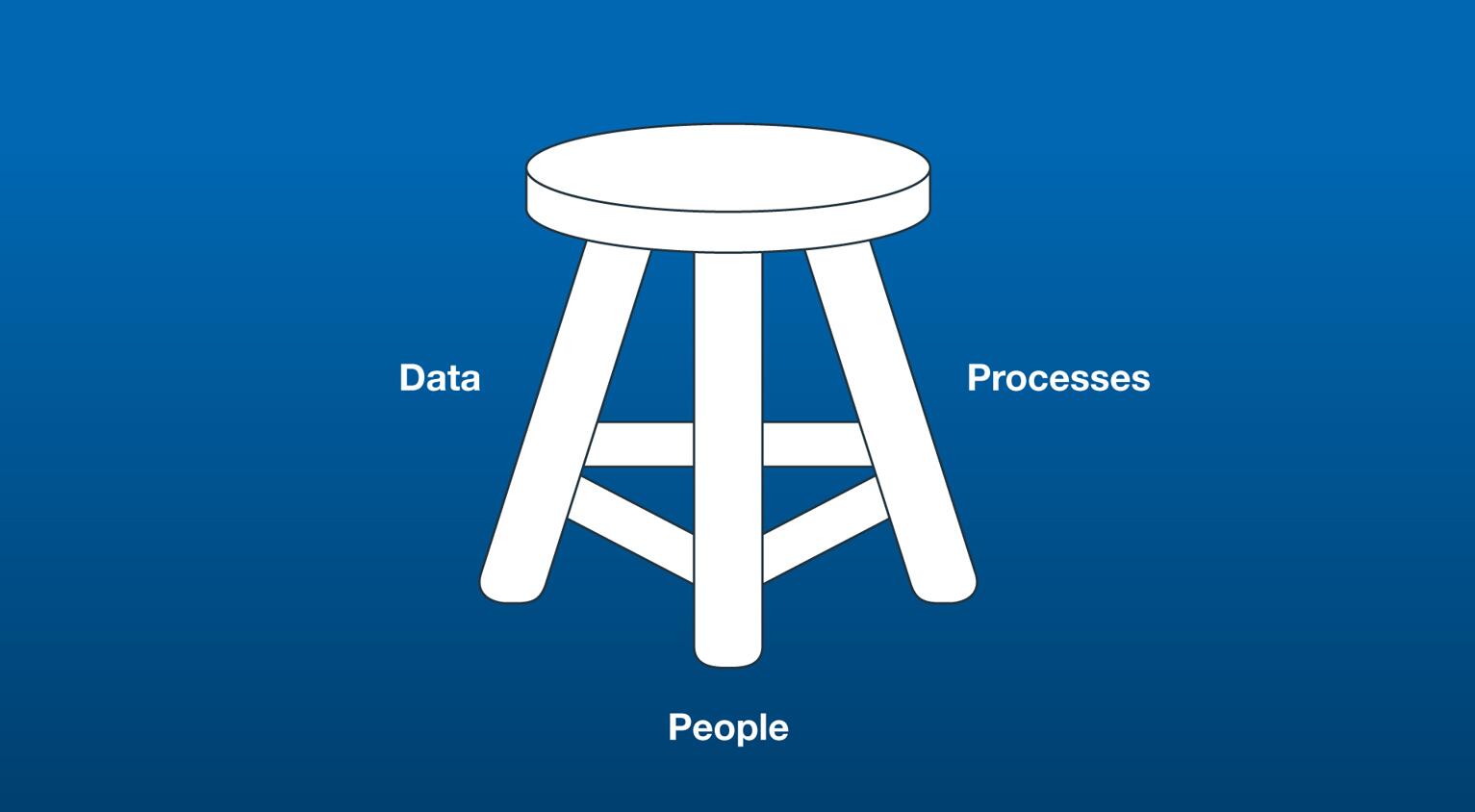
If one examines the global construction industry over 20 years, its growth has stagnated when compared to other industries. Looking at manufacturing specifically, which was already incredibly optimized, this sector has managed to double its productivity growth over the same period. This presents the construction industry with both a challenge and an opportunity.
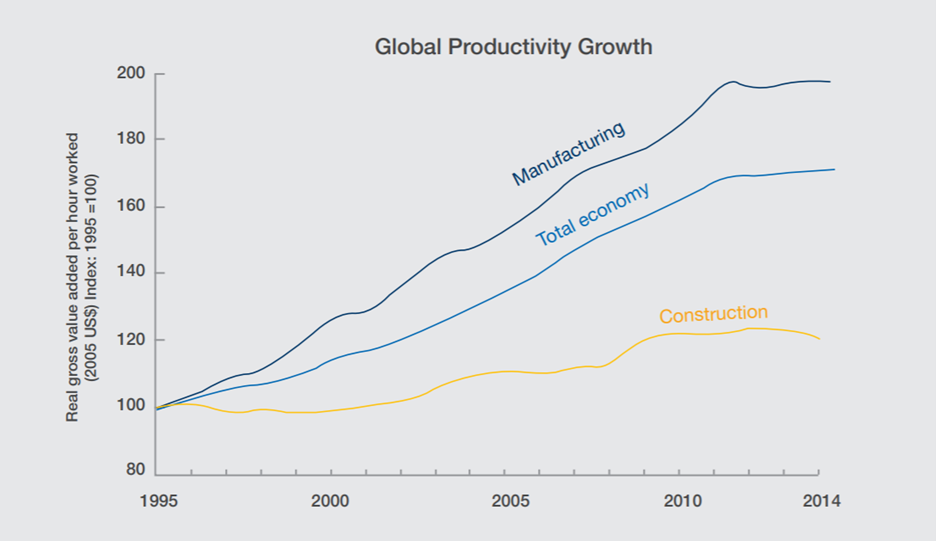
Global industry productivity and performance 1995 – 2015
(Source: Fuchs et al., Navigating the Digital Future: The Disruption of Capital Projects, 2017)
The construction industry is ripe for change…for four reasons:
1. According to McKinsey, if construction’s productivity had grown at the same rate as the global economy the added value would equate to $1.6 trillion.
2. The second reason is linked to two deeply rooted challenges: cost and schedule overruns. Examining the accompanying graph, the average delay for a construction project is 20 months with an average cost overrun of 80%. For such a low-margin industry, with single-digit percentages, these overruns are extremely problematic but also present the construction industry with the chance to do things differently.
3. This industry is also one of the world’s most undeveloped when it comes to technology and invests far less in IT than other sectors.
4. Several mega-trends also have the potential to profoundly impact the construction sector, including ageing infrastructure, population growth outstripping capacity growth, sustainability, changes in the way we engage with the workforce, evolving politics, and regulatory pressures.
How digital transformation benefits construction companies
Whether it's automation for improved productivity and performance, cloud-based software for greater collaboration, or the use of digital technology for onsite risk management through offsite manufacturing; digital transformation offers a host of qualitative benefits across the value chain. Most business leaders, however, agree that the biggest advantage will be experienced in the field of project management and performance.
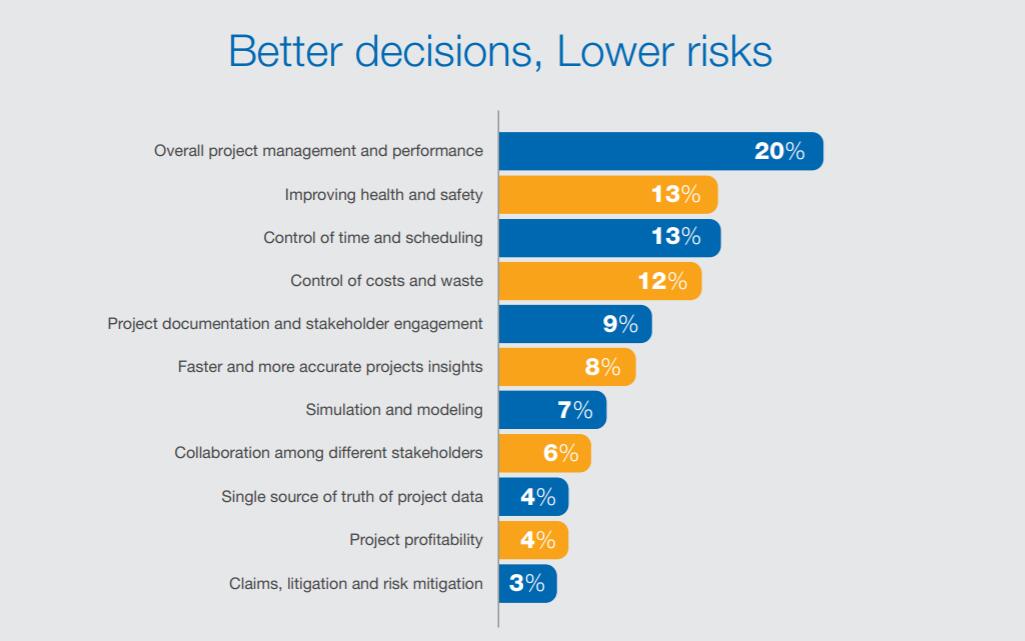
Source: IDC, Digital Transformation: The Future of Connected Construction, 2020
The three key transformation pillars for successful digital transformation in construction

First pillar: empowering people
It's really people working together that create great buildings, thus, a unique advantage is manifested when bringing together all relevant project stakeholders from the get-go. By getting all brains in the game, we can optimize what we need to do and ensure we have real-time connectivity between what we are doing on site and in the office.
Remaining consistent with the topics and studies discussed so far, the most important transformation areas for the construction industry are people. For this reason, when talking about the first steps towards digital transformation they must be discussed in relation to this area.
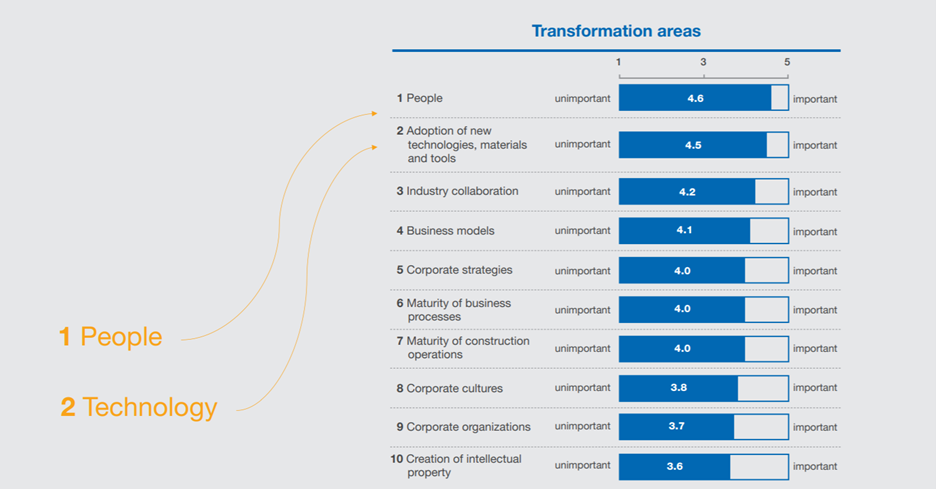
Source: De Almeida & Bühler, Shaping the Future of Construction: A Breakthrough in Mindset and Technology, 2016.
In terms of people, we need to ensure two things.
1) Help people adapt to new technology, new thinking, and new working methods.
Change in any organization will always face resistance, with this, we can be certain. In the construction industry, legacy procedures still dominate, and for many, the perception of migrating to a new construction management software seems almost antithetical to “the way things are done”.
However, there is no doubt that within this soon-to-be obsolete paradigm of doing things, frustration with existing project delivery systems and processes can run high in any project. As a result, more and more companies are turning to construction management software, and by proxy, leaner digitalized management systems.
After diving into the features and benefits of different construction management software available on the market, and carefully selecting the best one for their business, the next step is to get their people to change their way of working, accepting the new software, and finally actually using it.
Adopting a new software is not only a shift in the workflow but also a shift in the way of thinking and working methods, and though there is a learning curve, the pay off is well-worth the effort.
2) Help people communicate and collaborate efficiently with a true platform.
A vital strategic imperative heading forward is to ensure that your organization moves from desktop into Cloud and Mobility, and that you take your people from fragmented, disconnected offline tools and connect them on a unified platform supported by data and business intelligence. By doing so, your teams can be much more data-driven, much more connected, and much more collaborative, with the end result inevitably leading to a company-wide, and by extension, industry-wide increase in productivity.

Second pillar: connected data
The data-based world is moving exponentially, but the way we think, and the way traditional organisations operate is still linear. As a result, most industries find themselves in a mode of complacency, so when an exponential trend appears they are immediately disrupted. Unfortunately, when this occurs it is often too late to respond.
Historically, the construction industry has been positioned in the same complacent segment. For it to survive and thrive, however, organisations need to respond proactively and in strategic ways to avoid being swept over by future exponential trends.
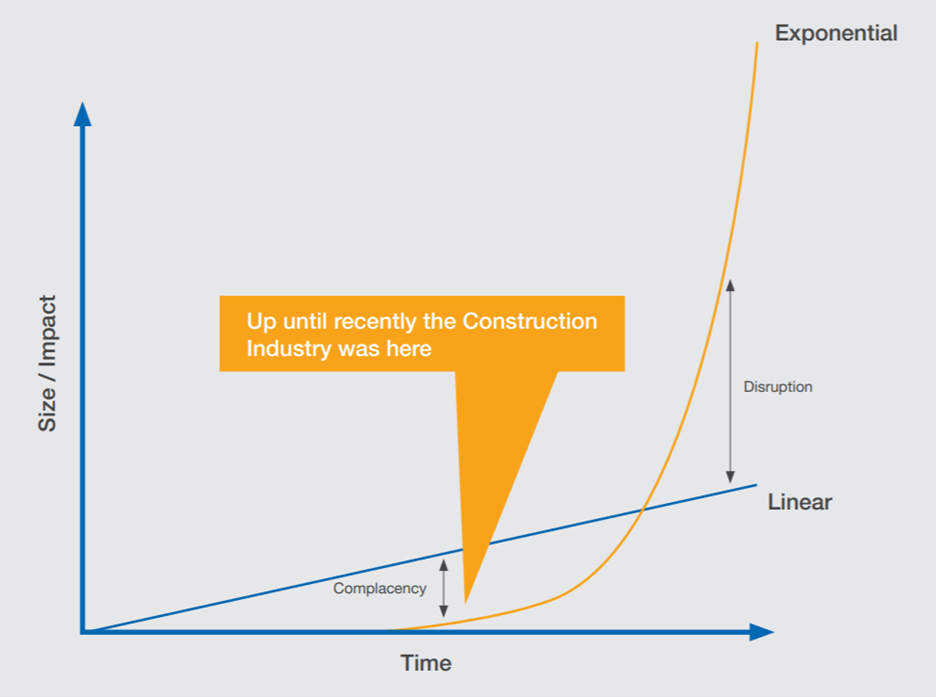
Based on Exponential Organizations : Why New Organizations are Ten Times Better, Faster, and Cheaper Than Yours (and What to Do About it), by Salim Ismail, Michael S. Malone and Yuri van Geest, Singularity University, 2014
BIM allows an organisation to unlock the true value of their data and that is why it is critical to implement the right solution when embarking on your digital transformation journey. When it comes to data, we are really talking about three aspects: the central database, real-time access, and data analytics.
1) Cloud-based central database. A central database needs to sit at the core for the data we mostly see today is collected in silo tools.
2) Real-time access. Real-time access to information is critical. Most construction projects today run in a reactive nature due to lacking real time integration to data.
3) Data analysis. For data analysis, we need to be able to have dashboard capabilities in which we can drill down to the relevant data and insights at any point in time and with speed.
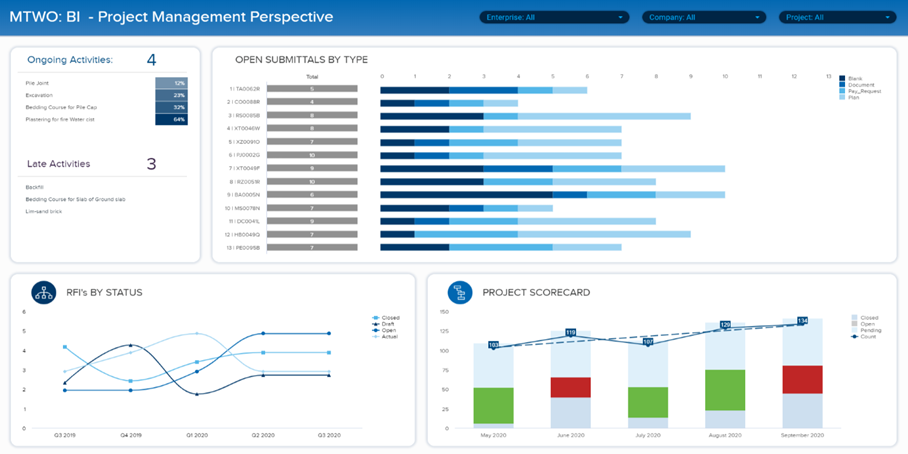
Third pillar: connected processes
The building lifecycle and workflows need to be connected since, as construction processes are causal by nature, if your teams use different applications for different specific processes and, as often happens, work orders and plans change, the knock-on effect can be lost time, budget overruns, and unforeseen challenges. Digital platforms that allow for instance connectivity can help to drastically cut such project challenges.
Imagine starting in the planning phase with such connectivity with all relevant stakeholders. This would mean that the instance a design is changed, changes in quantity takeoffs and costs can be seen immediately, or when a project owner suggests changing course, that the effect on cost, time, and final outcome can be calculated instantly. This is the power of connectivity.

The critical step? Connecting all people, data, and processes together.
When these three pillars are not integrated, teams are not able to fully comprehend the impact of any change, any action, and any decision on scheduling, budget, and timelines. Subsequently, our beloved projects can be an inefficient and risky environment to operate in.
To drive our business to become more productive, connect these three pillars, and witness the manifestation of exponential growth in your company’s productivity. A unified platform would be an ideal solution as on top of the enterprise platform, it has ample purpose-specific and integrated applications that enable different team members to do their work. These applications are accessible over tablets, phones, desktops, wherever and whenever. When you have such a platform in place, your stakeholders can collaborate easily, solve problems quickly, and create value effectively and efficiently.
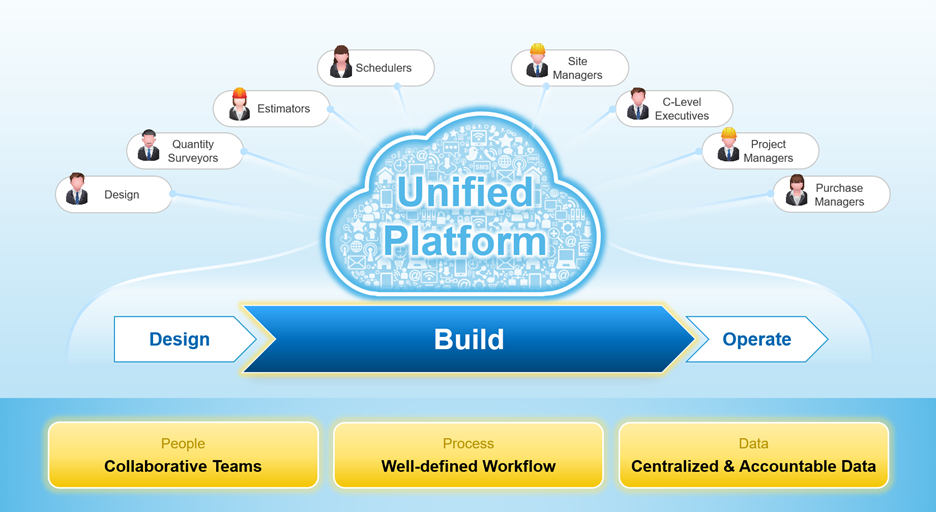
Software
MTWO Construction Cloud RIB SoftwareSource: https://www.mtwocloud.com/post/the-3-critical-pillars-for-successful-digital-transformation











